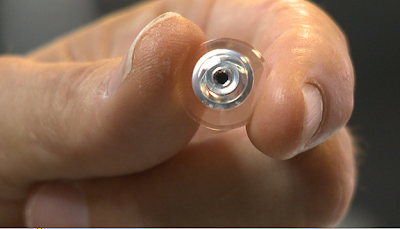A Telescopic Contact Lens
In an effort to help improve the vision of patients suffering from eye disease, engineers from the Jacobs School of Engineering at UC San Diego have developed a telescopic contact lens that can switch between normal and magnified vision.
A team of engineers has designed a telescopic contact lens that can switch between normal and magnified vision by using slightly modified off-the-shelf 3D television glasses. The researchers, led by Joseph Ford, a professor of electrical engineering at the University of California, San Diego, built a prototype of the lens and tested it on a mechanical eye. Researchers report their findings in the June 27 online issue of Optics Express, an open-access journal of the Optical Society.
The new lens could ultimately be used to improve vision for patients suffering from eye disease, including age-related macular degeneration, or AMD, a condition that causes loss of vision in the center of the visual field. Patients typically cannot read or recognize faces.
Ongoing research on the lenses is funded through a larger research program. Last summer, UC San Diego researchers worked with partners at Innovega and Paragon Vision Sciences to conduct human clinical trials on a preliminary version of the wearable lens. A second round of clinical trials will occur later this year.
Said Ford, the principal investigator on the project, “While there is a great deal of work still ahead, we see a clear path to a comfortable low-vision aid powered by a contact lens, which will help a significant number people who have impaired vision.”
The contact lens developed by Ford’s team is one millimeter thick. Researchers used aluminum mirrors, fit tightly together, to create a ring-shaped telescope embedded in the contact lens. The center of the lens allows for normal, non-magnified vision. Its periphery, where the telescope is located, magnifies images 2.8 times.
The telescopic contact lens, once fine-tuned, will be less invasive than the miniature telescopes that can currently be implanted into patients’ eyes. In addition, the lens the researchers developed does a better job at collecting light. The lens is also less bulky than telescopes mounted on glasses that are currently available to help patients with impaired vision. The contact lens’ optics make it possible to switch between normal and magnified vision by combining the contact lenses with glasses such as the “active shutter” glasses worn to watch some 3D televisions.





Comments
Post a Comment